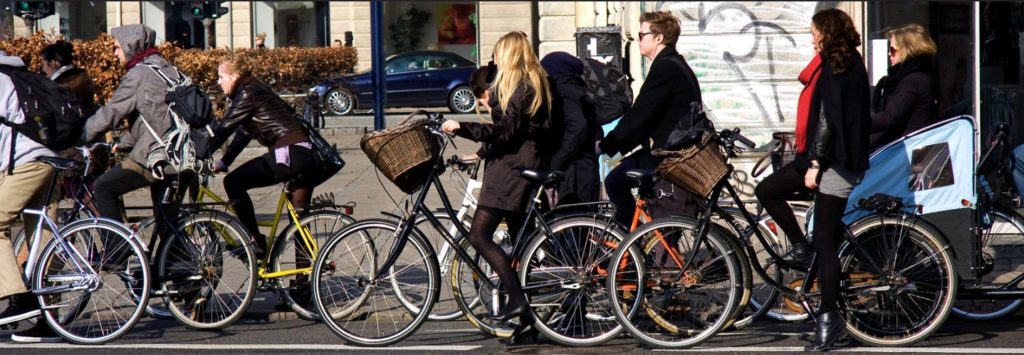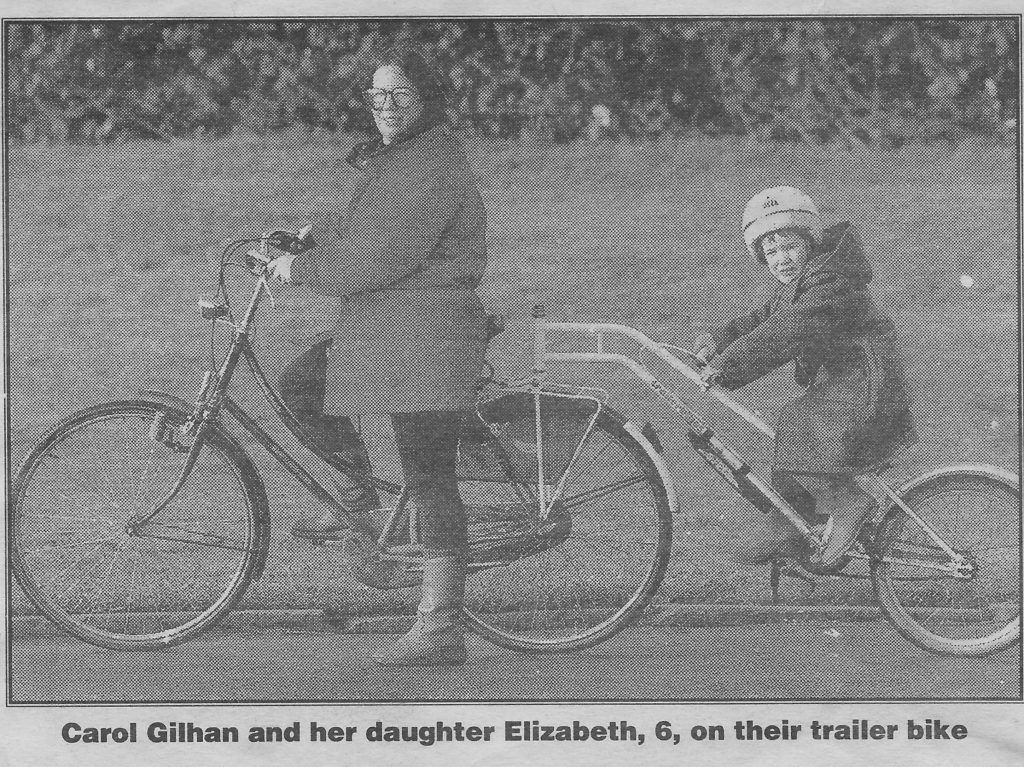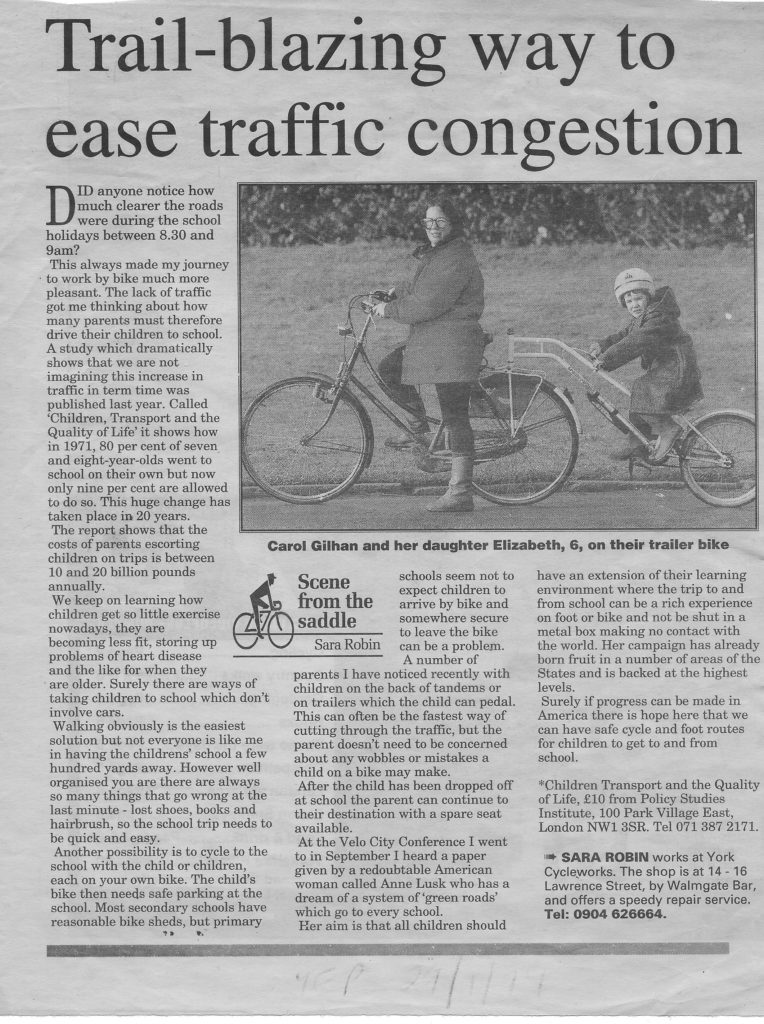
John Gilham
Normal? It used to be. Half the pupils of my secondary school in suburban London cycled to and fro in the 1960s; in York a huge number of the workforce of the carriage works, Terrys, and Rowntrees used to cycle to work. Absolutely normal!
Some people in York, asked why they don’t cycle, reply “it’s too dangerous.” No it’s not. Not more than being a pedestrian or going by car. But if you are going to use a bike as transport from A to B, from Clifton to Fulford, from Dringhouses to Heworth, you’ll need a cycling mindset to put on with your cycle-clips. Not a car-driving mindset, not a taking the bus mindset, not even a pedestrian mindset. You will be on the road but not in a bus – you can go places buses don’t/can’t go. Not in a car – you can go places cars can’t go. Cars love wide roads and big junctions. They like the Fishergate gyratory and the fast roundabouts on the Ring Road. They don’t like back streets, roads with humps, chicanes, bollards, bike creeps, bike paths – all things that bikes love. You have so many more choices on a bike. A cycling mindset is as important, if not more so, in cycling safely than a helmet.
A bike mindset doesn’t come naturally. A child brought up in the average car-owning family, if they notice where they are being taken at all, will know car routes, maybe some bus routes too. No wonder they hesitate to get on a bike to visit their friends, go to the shops or the library. Cycling is for a fine afternoon with Mum and Dad, maybe out to Naburn on the Selby cycle track.
Or maybe the bike is freedom (and of course it does bring freedom) to be expressed by riding on the pavement, through red lights, on the wrong side of the road, no signals, no lights, doing a wheelie down Blossom Street. “It’s not dangerous? Let’s make it so.”
How to make A to B cycling normal and safe for children? If it’s three generations since the family always had a family car, the parents aren’t unlikely to have the cycling skills to pass on. Normal cycling isn’t just sitting on the saddle and heading down the street. The National Cycling Proficiency scheme was brilliant, succeeded by Bikeability, training offered by City of York Council and others. This should be offered free to all schoolchildren but also to adults. Could this be done at York Central? Volunteer trainers maybe?
But there’s more to the cycling mindset than knowing where to position yourself on the road, how to signal and turn, especially turning right, and basic information on how the bike works and simple maintenance. As I’ve hinted above, it’s about route planning, finding the back doubles and the cycle paths, not using a GPS designed for cars, and avoiding points of potential conflict with motor traffic, like the Fishergate gyratory or those Ring Road roundabouts.
Do I know what I’m talking about? Have I lived the dream? My wife, Carol, and I have lived in York since 1976, first within the walls in Bishophill then on Scarcroft Road (which is the last gasp of the A59, incidentally). We have never owned a car and do not drive. Bikes are our main form of local transport, for shopping, work and leisure. And throughout the 80s and 90s, for getting our three children where they needed to go. School was two miles away, off Fulford Road near where Aldi is now, and there was no Millennium Bridge. I would take them on the way to work in the morning, Carol would bring them home. Friends’ houses and extracurricular activities were all over the city. Using some child bike seats and at various times a tag-along, an adult tricycle with two child seats, a tandem and a hierarchy of children’s bikes which they could ride themselves they learned to ride confidently on roads, through traffic, and on bike routes and short cuts. They, and their own children, all still cycle for transport, though each family does have a car, mostly for work purposes.
How did I manage work without a car? I worked for nearly 30 years for a small company which built and managed social housing, mostly in York but also across the East Riding and parts of North Yorkshire. I managed the build programme, liaising with local authorities, agencies, architects and builders. In those days before Zoom it involved face-to-face meetings and site visits. It could all be done using public transport and a folding bike. Not normal, maybe, but possible. Note: leisure rides further afield are facilitated by taking the folder on the bus or train to start and/or finish – e.g. Malton to Bishop Burton, or Pocklington to Seamer. The X46 York-Hull bus also takes full size-bikes. Not normal, maybe, but possible.
Same applies to family shopping, mostly in the local community, using panniers; occasionally a bigger shop using a marvellous contraption called a bike-hod. Huge capacity.
Full disclosure: the only time in my life I have regretted not having a car is during this pandemic. Advice against using public transport means we can’t join the car-borne taking the virus to distant beauty spots on fine days, Filey, Scarborough, the Moors, Barnard Castle. Hard cheese, bike boy!
Carol Gilham

Although I was raised in a second generation car owning family, I was only too pleased to live without one. For me, it was about independence as a young woman—I didn’t need to earn enough to buy and run a car, I never needed to look for a parking spot, I got to know York’s back roads and byways, neighbourhoods, outer villages and surrounding countryside and I could experience the thrill of swooping around the Minster and over one of the bridges on a late summer evening, a glorious sky overhead. These still apply now I am a grandmother.
Was it always dry and sunny? No, but I have a serious collection of waterproof garments and do not mind the rain, as long as I can get dry clothes on back at home.
And now I have an electric bike, which increases my range as I get older. I still can’t keep up with my grandchildren, but that is mostly because they are recklessly speedy and I am not.
Our focus on cycling was also about giving our children independence. They did not need to wait to be taken somewhere or be collected—they could learn to go further and further afield as they grew more confident and competent. And we didn’t need to wait up for the phone call asking to be collected—they returned under their own steam after a night out, often bringing a collection of friends. It made for a very sociable household, and our children knew each other’s friends and looked out for each other. I’ve strayed a bit—but the wider social implications are as important as pushing the pedals. The invention of bicycles (and bloomers!) is credited with empowering the Suffragettes.
